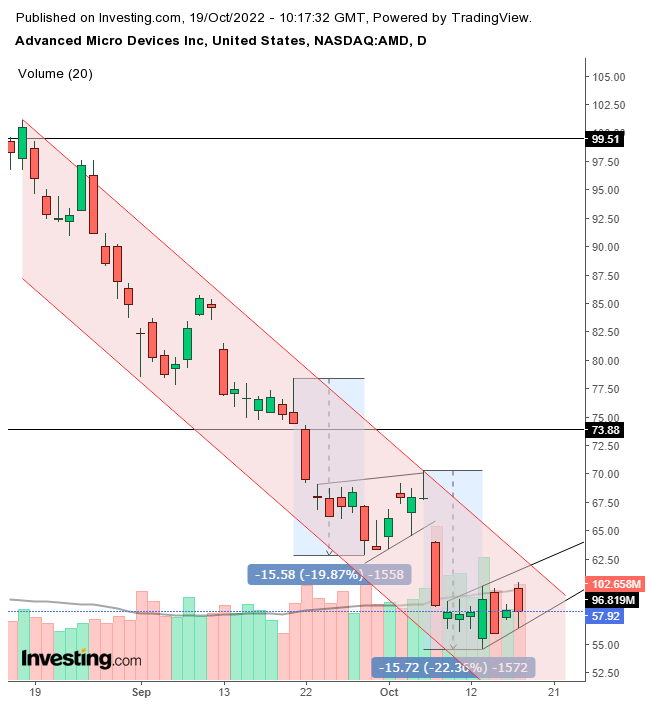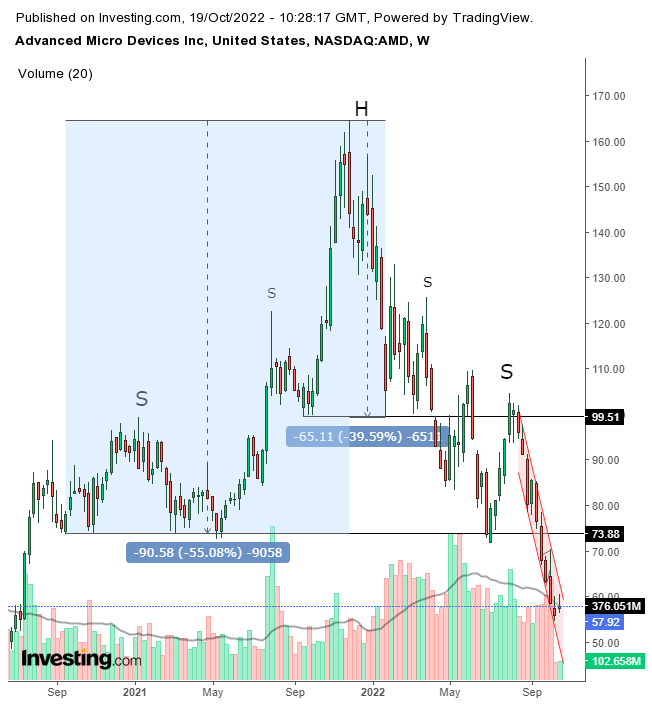U.S. stocks edge higher after weekly jobless claims; Salesforce gains
Two and a half months ago, I wrote why AMD may be about to crash. I made the argument that weak guidance will overshadow strong fundamentals.
Sure enough, the company's valuation has plunged since. Advanced Micro Devices' (NASDAQ:AMD) current market cap of $93.57 billion, is down 46%.
Analysts relying solely on fundamentals have been overwhelmingly positive about the company's valuations, expecting it to rise. A Wall Street Journal (WSJ) survey demonstrates that these analysts have become more bullish as the tech giant's market cap slides.
Three months ago, the WSJ had 22 buy versus one sell recommendation. One month ago, that ratio widened to 25 recommending a buy and again 1 to sell. Currently, the WSJ has 27 buys and zero sell recommendations on the stock.
Tipranks shows the same solid consensus: 20 buys versus 1 sell, with an average price target of $97.50, a 56% upside. The highest target is $200, a 73% surge.
My target is $34.

The stock may be developing a second consecutive rising flag. After the company lost a fifth of its value in three sessions, short sellers quickly locked in profits. The following congestion represents the crowded trade between short sellers buying back the stock and ongoing supply by other short sellers. The downside breakout, like for the first flag, should repeat the move to the downside, as the market uncorks the pattern's trading pressure to the downside once supply drowns out the demand created by the short covering.
The target is, therefore, a $15 downside move from the breakout point, which should be around the low $40s. However, there's more.

As I described in my August article, the preceding H&S—Aug. 2, 2021 to Apr. 11, 2022—indicates a much lower target. The H&S height of $65 is the expected downside move from the breakout, as technicals statistically slingshot prices downward proportionately to how far prices stretched the other way. Therefore, the $99 breakout point minus $65 is $34.
Moreover, there is an even larger H&S top at play. Its $90 height seems to suggest a repeat performance from the $74 breakout point. However, that would take the price below $0. I honestly don't have experience with this pattern being larger than a company's stock's previous gains and am therefore not considering this target. This anomaly is another example of market distortions after the significant quantitative easing that took place during the coronavirus pandemic.
Trading Strategies
Conservative traders should wait for the current flag to complete with a downside breakout, or if it blows out, to find resistance by the first flag. Then, wait for resistance confirmation with either flag.
Moderate traders would wait for the same, as well as for the return move, but a closer entry if not for confirmation.
Aggressive traders could short upon the current flag's downside breakout, on a closing basis, or upon a return to the first flag.
Trade Sample - Aggressive Short
- Entry: $57
- Stop-Loss: $60
- Risk: $3
- Target: $45
- Reward: $12
- Risk-Reward Ratio: 1:4
Disclaimer: The author has no positions in any securities mentioned in this article.
